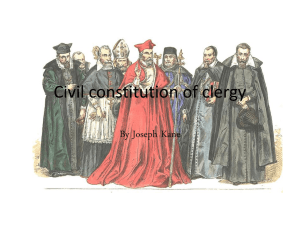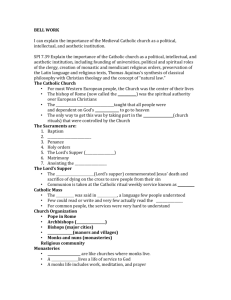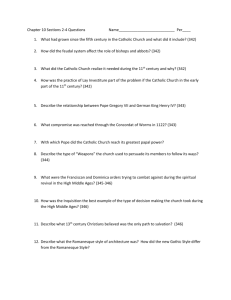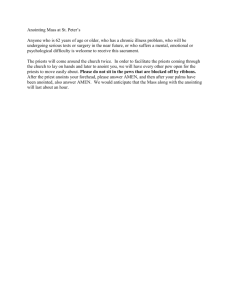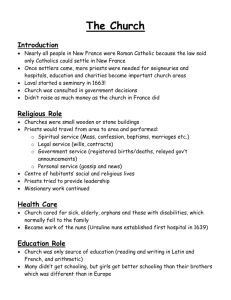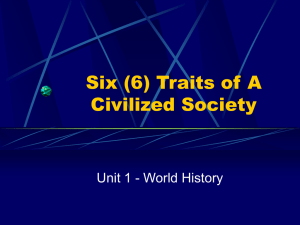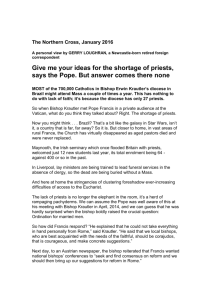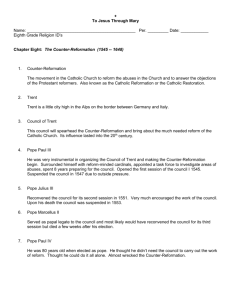Religion in the Middle Ages
advertisement
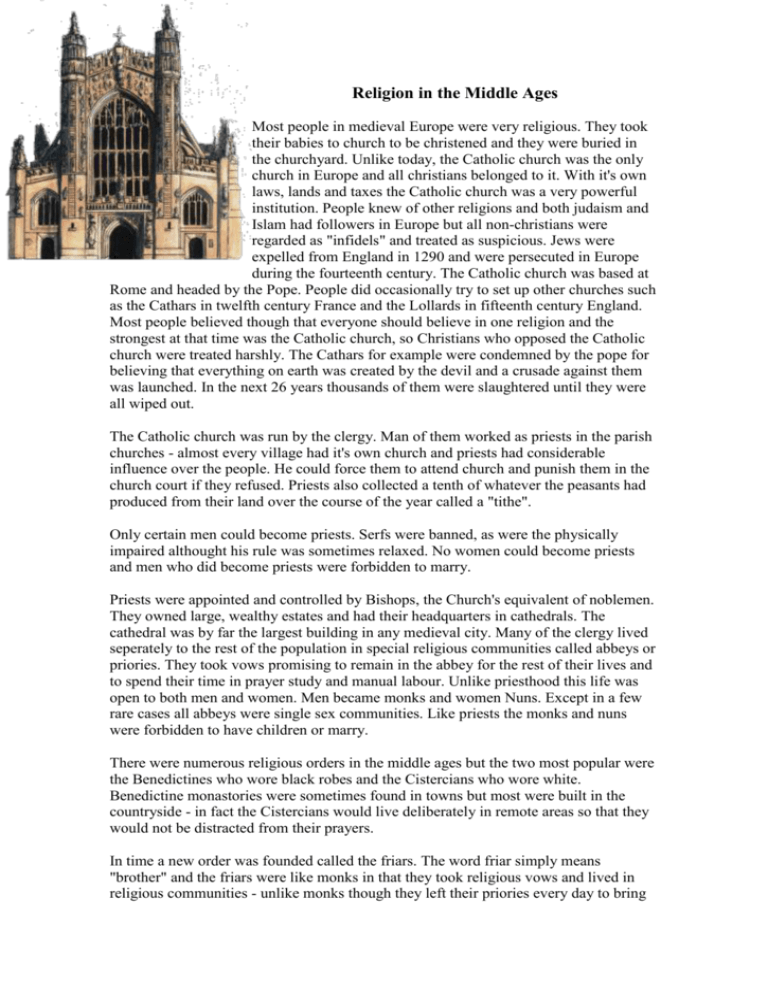
Religion in the Middle Ages Most people in medieval Europe were very religious. They took their babies to church to be christened and they were buried in the churchyard. Unlike today, the Catholic church was the only church in Europe and all christians belonged to it. With it's own laws, lands and taxes the Catholic church was a very powerful institution. People knew of other religions and both judaism and Islam had followers in Europe but all non-christians were regarded as "infidels" and treated as suspicious. Jews were expelled from England in 1290 and were persecuted in Europe during the fourteenth century. The Catholic church was based at Rome and headed by the Pope. People did occasionally try to set up other churches such as the Cathars in twelfth century France and the Lollards in fifteenth century England. Most people believed though that everyone should believe in one religion and the strongest at that time was the Catholic church, so Christians who opposed the Catholic church were treated harshly. The Cathars for example were condemned by the pope for believing that everything on earth was created by the devil and a crusade against them was launched. In the next 26 years thousands of them were slaughtered until they were all wiped out. The Catholic church was run by the clergy. Man of them worked as priests in the parish churches - almost every village had it's own church and priests had considerable influence over the people. He could force them to attend church and punish them in the church court if they refused. Priests also collected a tenth of whatever the peasants had produced from their land over the course of the year called a "tithe". Only certain men could become priests. Serfs were banned, as were the physically impaired althought his rule was sometimes relaxed. No women could become priests and men who did become priests were forbidden to marry. Priests were appointed and controlled by Bishops, the Church's equivalent of noblemen. They owned large, wealthy estates and had their headquarters in cathedrals. The cathedral was by far the largest building in any medieval city. Many of the clergy lived seperately to the rest of the population in special religious communities called abbeys or priories. They took vows promising to remain in the abbey for the rest of their lives and to spend their time in prayer study and manual labour. Unlike priesthood this life was open to both men and women. Men became monks and women Nuns. Except in a few rare cases all abbeys were single sex communities. Like priests the monks and nuns were forbidden to have children or marry. There were numerous religious orders in the middle ages but the two most popular were the Benedictines who wore black robes and the Cistercians who wore white. Benedictine monastories were sometimes found in towns but most were built in the countryside - in fact the Cistercians would live deliberately in remote areas so that they would not be distracted from their prayers. In time a new order was founded called the friars. The word friar simply means "brother" and the friars were like monks in that they took religious vows and lived in religious communities - unlike monks though they left their priories every day to bring religion to the masses. The friars adhered to a strict vow of poverty and had to beg for everything. The two most important orders of friars were the Franciscans and the Dominicans. As a result of the churches work it became both rich and influential. Anyone who was suspected of disagreeing with the Church's teachings was called a heretic and burnt at the stake. Many believed that even if they did make it to heaven in the afterlife they would have to spend a thousand years in purgatory to be cleansed of their sins on earth ready for the paradise of heaven. So many rich people would pay the church to say extra masses for them in the hope that it would reduce the amount of time in purgatory. In 1302 Pope Boniface issued the bull (papal law) Unam Sanctum, which stated that the pope had complete authority over not only the church but also over all the kings and rulers in the world. The bull declared that disobedience to the pope's wishes would result in the guilty going straight to hell. One year later King Philip IV of France captured and imprisoned the 86 year old pope who died of shock. The next pope , Clement V, was a frenchman and instead of living in Rome like all previous popes he decided to move to Avignon, a city in Provence. For the next 70 years all popes were French and lived in Avignon. Pope Gregory XI returned to Rome in 1378, but after his death a schism (split) occurred amongst the cardinals (the leading churchmen). Some supported the Italian candidate Urban VI; others elected Clement VII and moved back to Avignon. The "Antipope" Clement VII was lame, had a squint and was violent and merciless. Urban VI on the other hand became crazed with power and until the end of the fifteenth century there were two popes, each of whom excommunicated the followers of the other.
